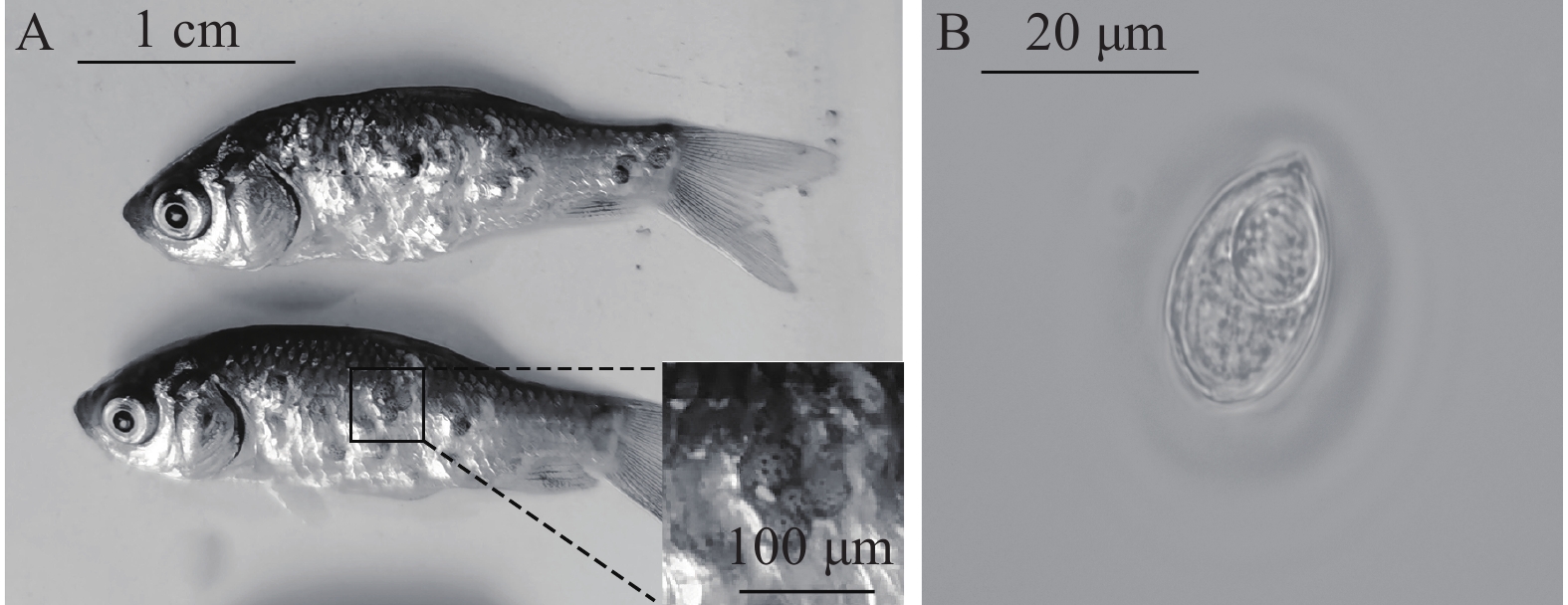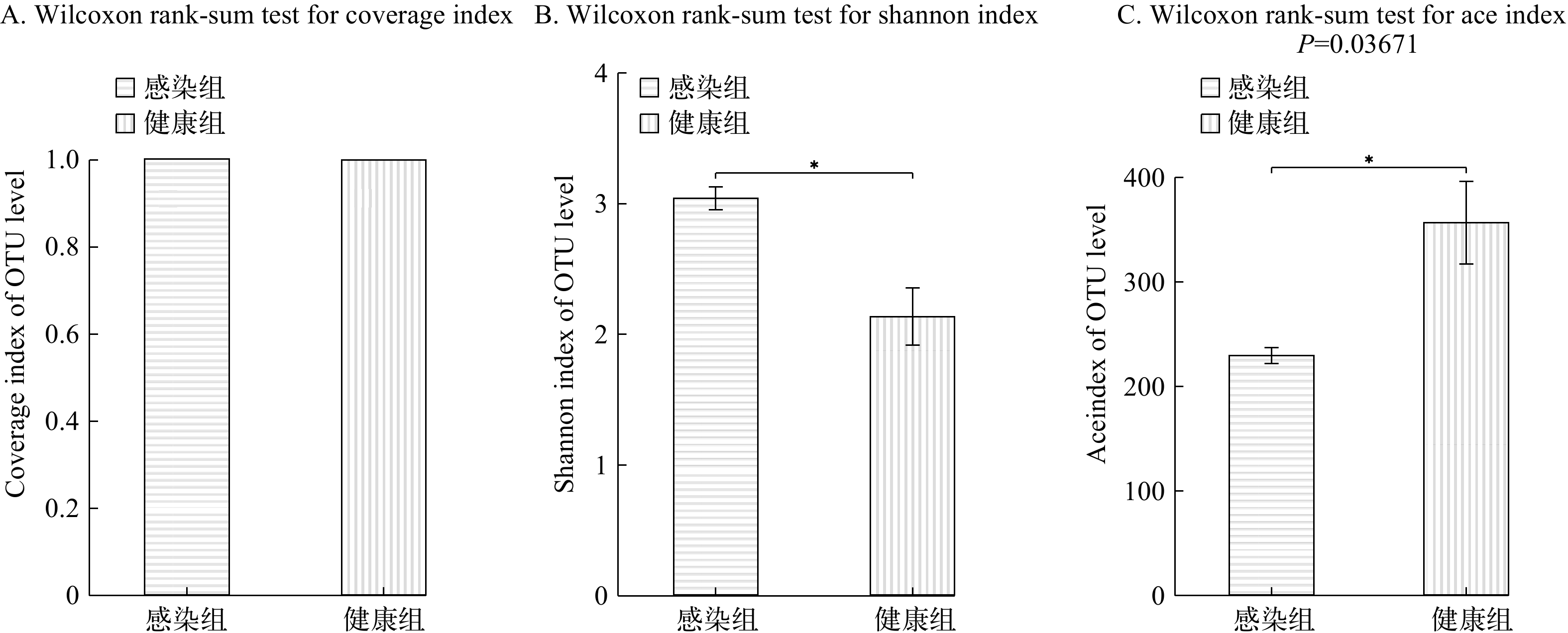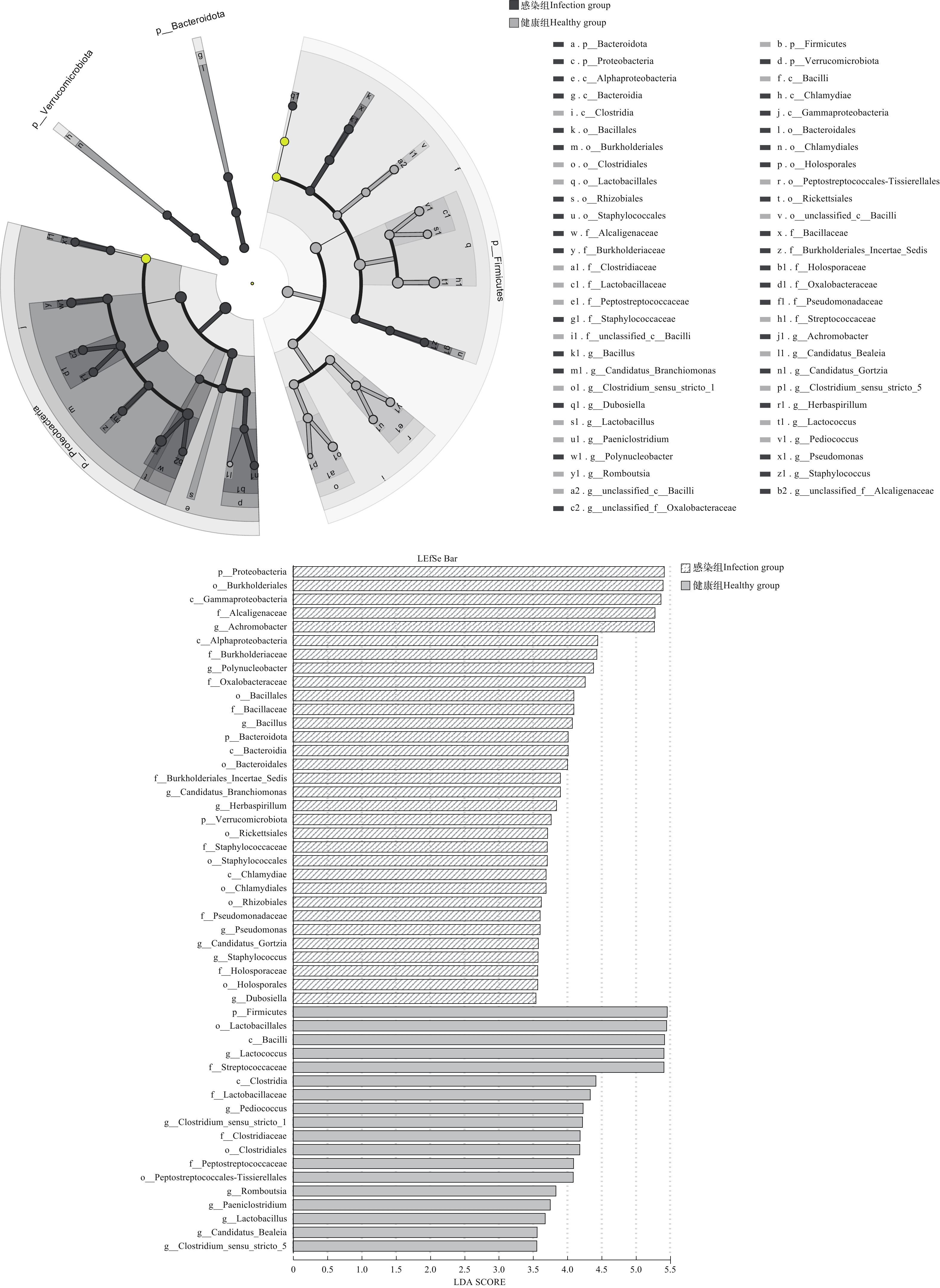SKIN MICROBIOTA ANALYSIS OF GIBEL CARP (CARASSIUS AURATUS GIBELIO) INFECTED BY THELOHANELLUS WUHANENSIS XIAO & CHEN, 1993
-
摘要:
研究以异育银鲫为研究对象, 通过16S rDNA高通量测序分析, 探究武汉单极虫感染对其皮肤微生物物种组成、丰富度和多样性的影响。结果显示, 健康组和感染组异育银鲫皮肤微生物共有30门、80纲、188目、295科、475属、692种、939个OTUs, 其中健康组特有OTU数为308个, 感染组特有OTU数为342个。根据α多样性分析发现, 感染组微生物多样性较健康组显著升高、丰富度显著降低; β多样性分析发现, 健康组和感染组皮肤微生物群落结构存在显著差异。比较分析发现, 在门水平上, 健康组和感染组优势菌门均为厚壁菌门(Firmicutes)、变形菌门(Proteobacteria)、蓝藻门(Cyanobacteria)、放线菌门(Actinobacteria)和拟杆菌门(Bacteroidetes), 但在丰富度上存在差异; 在属水平上, 丰富度在1% 以上的有20 个属级单元, 健康组以乳球菌属(Lactococcus)为主, 感染组以无色杆菌属(Achromobacter)为主, 分别占各组总微生物数量的58.99%和48.67%。线性判别分析和功能预测发现, 感染组中致病菌的丰富度和微生物潜在致病性较健康组显著增加。综上所述, 武汉单极虫感染能够引起异育银鲫皮肤微生物失调和致病菌丰富度增加, 进而可能导致细菌的继发感染。
Abstract:Thelohanellus wuhanensis Xiao & Chen, 1993, a pathogen of “skin myxosporidiosis”, infects the skin of gibel carp (Carassius auratus gibelio), and can cause significant mortality in juvenile fish. Currently, researches on T. wuhanensis has primarily focused on its identification, pathogenicity, and life cycle, with little attention has been paid to the potential bacterial secondary infections it may cause. Here, the skin microbiota analysis (including the species diversity, composition, and abundance) of Carassius auratus gibelio infected by T. wuhanensis was conducted using high-throughput 16S rDNA sequencing. The results indicated that both the healthy and infected groups of C. auratus gibelio possessed a total of 939 Operational Taxonomic Units (OTUs) were obtained, belonging to 30 phyla, 80 classes, 188 orders, 295 families, 475 genera, and 692 species. The healthy group had 308 unique OTUs, while the infected group had 342 unique OTUs. The α-diversity analysis revealed significantly higher microbial diversity but significantly lower richness in the infected group compared with the healthy group. In addition, the β-diversity analysis demonstrated significant differences in the structure of skin microbial communities between the healthy and infected groups. At the phylum level, Firmicutes, Proteobacteria, Cyanobacteria, Actinobacteria, and Bacteroidetes were the dominant taxa in both the healthy and infected groups, although differences in abundance were observed. At the genus level, 20 genera exhibited a relative abundance exceeding 1%. The dominant genus in the healthy group was Lactococcus, while Achromobacter was the most prevalent in the infected group, representing 58.99% and 48.67% of the total microbial abundance, respectively. The results of the linear discriminant analysis (LDA) and functional prediction indicated a significant increase in both the abundance of pathogenic bacteria and the potential pathogenicity of the microbiota in the infected group in comparison to the healthy group. In conclusion, the infection of T. wuhanensis can disrupt the skin microbiota of C. auratus gibelio, leading to the possibility of secondary bacterial infection.
-
Keywords:
- Skin microbiota /
- Diversity /
- 16S rDNA /
- Thelohanellus wuhanensis
-
硬骨鱼类的黏膜层(皮肤、鳃、肠道等)及其共生微生物是宿主与外界环境接触的第一道屏障, 对宿主的健康和免疫具有重要作用[1]。黏膜层的共生微生物通过物质交换、能量流动和信号传递来维持黏膜层微环境的稳态, 从而调节宿主健康状态[2]。在鱼体健康状态时, 黏膜层微生物处于相对稳定的动态平衡, 当这种平衡被打破后, 菌群失衡可能影响鱼体健康[3]。鱼类终生生活在水中, 皮肤黏膜层作为鱼类最大的黏膜层组织, 是抵御环境微生物侵害的第一道防线, 但目前关于鱼类皮肤微生物的研究还处于初始阶段[1, 2]。
寄生虫是水产养殖中主要的病原之一, 对鱼类苗种直至成鱼各个阶段的危害都十分严重。部分寄生虫可寄生于鱼类体表和鳃上, 对寄生处皮肤造成机械性损伤, 并可引发皮肤充血、炎症及细菌性继发感染[4]。车轮虫通过黏接盘, 破坏宿主鱼的鳃和皮肤, 严重时可引起鱼类大规模死亡[5, 6]。瓦氏黄颡鱼感染多子小瓜虫后, 皮肤出现小白点, 严重时皮肤隆起或破溃, 导致鱼类大量死亡[7]。刺激隐核虫能够引起刺激隐核虫病, 发病后鱼体表可见大量白点, 且其具有发病速度快、传染率强、致死率高的特点[8, 9]。目前对于皮肤寄生虫病的研究主要围绕在寄生虫病原生物学、免疫应答、组织病理等, 而对寄生虫感染所引起的细菌继发感染与致病缺乏关注[9—12]。
武汉单极虫(Thelohanellus wuhanensis)寄生于异育银鲫苗种皮肤, 可在皮肤形成大量隆起的孢囊, 严重时可导致宿主生长减缓、游动力弱、畸形、死亡等[13, 14]。目前, 已有多位学者对武汉单极虫感染临床症状、病原分离鉴定、组织病理学及生活史等方面开展了相关的研究, 但关于其感染后可能引起的细菌性继发感染还尚未有相关研究报道。本研究采用16S rDNA高通量测序技术分析武汉单极虫感染异育银鲫后皮肤微生物多样性差异, 解析异育银鲫感染武汉单极虫后皮肤微生物的组成、丰富度和多样性, 比较健康组和感染组的微生物的变化, 也为异育银鲫“肤孢子虫病”的防控积累资料。
1. 材料与方法
1.1 试验材料
2022年6月从湖南省常德市鼎湖区(29°10′36″E, 111°52′4″N)同一养殖池塘中随机选取健康和感染武汉单极虫的异育银鲫各50尾, 平均体长为(3.64±0.44) cm [体长(3.26—4.72) cm], 活鱼充氧运回湖南农业大学水产学院疾病实验室。
1.2 寄生虫学检查
宿主外观症状及武汉单极虫形态学观察:通过肉眼观察发现异育银鲫体表鳞片凹凸不平, 将鳞片拨开可见皮肤上有大量包囊。随机分离包囊制作涂片, 置于光学显微镜下进行观察、测量、拍照。参照指南进行测量和描述[15], 随机选取50个成熟孢子个体, 分别测量其成熟孢子长、宽、厚及极囊长、宽。测量数据均以微米(μm)为单位, 结果用平均值±标准差(变化范围)表示。同时, 将感染的组织保存于95%酒精中, 用于后续基因组提取。
寄生虫DNA 提取、18S rDNA 序列的扩增和测定:取95%酒精保存的皮肤组织, 用PBS缓冲液离心洗涤2次, 按照 DNA提取试剂盒(QIAGEN, 德国)进行DNA提取。PCR扩增采用黏孢子虫18S rDNA序列通用引物MyxospecF: 5′-TTCTGCCCTATCAACTWGTTG-3′[16]和18R: 5′-CTACGGAAACCTTGTTACG-3′[17]。PCR反应体系: 25μL 1×PCR mixture(康为, 北京), DNA模板2 μL, 正反引物各2.0 μL, 加双蒸水至50 μL体系。PCR反应程序: 94℃预变性4min, 35个循环: 94℃ 变性1min; 46℃退火50s; 65℃延伸90s; 65℃终延伸10min。取10 μL PCR产物经1%琼脂糖凝胶电泳检测后, 用胶回收试剂盒 (康为, 北京) 进行回收纯化, 并将目的片段连接到pMD 18-T 载体 (TaKaRa, 日本), 再转化到感受态细胞DH 5α 中, 50 μL/mL氨苄青霉素的LB 固体培养基均匀涂布并培养过夜, 挑取阳性克隆, 用于测序。测序在自动测序仪ABI PRISM 3730 DNA Sequencer (Applied Biosystems USA) 上完成。测序结果通过BioEdit[18]进行拼接, 并根据测序峰图人工校正 (DNASTAR INC., Madisom, Wis), 将拼接完毕的序列提交至GenBank。
1.3 皮肤微生物
样本提取:在无菌的条件下, 随机选取健康与感染鱼各5尾, 用镊子分离其皮肤并置于2 mL冷存管中, 液氮速冻后–80℃冰箱保存。
皮肤微生物的DNA提取、PCR扩增及测序分析:将皮肤样品送至上海美吉生物医药科技有限公司进行DNA提取、扩增与高通量测序。对10个皮肤样本进行DNA提取后, 利用NanoDrop2000平台测定DNA浓度与纯度。合格的DNA使用通用引物338F (5′-ACTCCTACGGGAGGCAGCA-3′)和806R(5′-GGACTACHVGGGTWTCTAAT-3′)扩增。构建配对末端测序文库并在Illumina MiSeq (上海美吉生物医药科技有限公司)上进行测序。
1.4 皮肤微生物数据处理及生物学统计分析
Illumina测序得到的PE reads首先根据overlap关系进行拼接, 同时对序列质量进行质控和过滤, 区分样本后采用USEARCH11-uparse算法对将相似性高于97%的序列聚类并进行分类学分析。序列抽平后用mothur[19](version v.1.30.2)计算Alpha多样性指数、通过Wilcoxon秩和检验分析其统计学差异、用Qiime[20]计算beta多样性距离矩阵, 利用LEfSe软件[21]寻找差异物种并结合LDA估算每个物种丰富度对差异效果影响的大小、BugBase进行表型预测[22]并通过Wilcoxon秩和检验表型组间差异。
2. 结果
2.1 武汉单极虫形态学描述和分子特征
病鱼体表有许多肉眼可见的包囊, 包囊表面出现较多的黑色素细胞(图 1A), 包囊直径大小为0.8—1.5mm。形态学观察发现, 成熟孢子壳面观呈瓜子状, 前端稍尖, 后部钝圆; 缝面观呈柠檬形, 极囊1个, 近似球形, 位于孢子前端(图 1B)。成熟孢子长(22.22±1.32) μm [(19.83—24.76) μm], 宽(13.67±1.00) μm [(12.20—16.76) μm], 厚(11.64±0.48) μm [(10.73—12.52) μm]。极囊等大, 梨形, 长(10.48±0.64) μm [(8.72—11.79) μm], 宽(7.86±0.56) μm [(6.73—9.30) μm], 极丝圈数为7—9圈。利用黏孢子虫通用引物成功扩增得到1730 bp 18S rDNA基因片段,BLAST比对发现其与GenBank中武汉单极虫序列相似性为99.25%。结合形态学观察、寄生特性(宿主与寄生部位)及分子序列比对, 本次分离的黏孢子虫鉴定为武汉单极虫。
2.2 16S rDNA基因测序结果分析
对提取的10尾鱼皮肤样本进行16S rDNA高通量测序, 10个样本一共得到有效序列542089条, 平均长度为424 bp。在97%相似水平下对所有序列进行聚类, 可划分为939个OTU, 隶属于30个门、80个纲、188个目、295个科、475个属、692个种。感染组特有OTU数为342个, 健康组特有OTU数为308个(图 2)。
稀释曲线可以用来判断测序数据量是否足够, 健康组和感染组稀释曲线如下(图 3)。本次测序的10个样品, 稀释曲线逐渐趋于平缓, 说明测序数据量已足够, 可以反映样本中绝大多数的微生物信息。
2.3 皮肤微生物多样性分析
α多样性分析:根据皮肤微生物OTU数量, 对其进行α多样性指数分析。群落丰富度常用Ace指数和Chao1指数表征, 群落的多样性由以Shannon指数和Simpson指数衡量。每组样品的覆盖度指数(coverage)均达到0.997以上, 表明测序结果可靠(图 4A)。比较健康组和感染组皮肤微生物, 发现与健康组相比感染组的Shannon显著升高, 而Ace指数显著降低 (图 4B和4C)。
β多样性分析:通过UPGMA算法在OTU水平上构建的层级聚类树(图 5), 分析健康组和感染组皮肤微生物群落组成的差异性。聚类分析将样品分为两支, 健康组和感染组分别聚为一支, 表明样品重复性较好, 且两组皮肤微生物群落结构存在差异。通过主坐标分析(Principal co-ordinates analysis, PCoA)进一步探讨健康组和感染组在属水平上皮肤微生物群落组成的差异性(图 6)。PCoA分析解释了两组皮肤微生物群落总差异的82.87%, 其中PC1解释了微生物群落总差异的72.66%, PC2解释了微生物群落总差异的10.21%。进一步证明了两组皮肤微生物具有显著差异(P<0.05)。
2.4 皮肤菌群差异分析
分析发现, 本研究皮肤样本共检测出5个优势菌门, 包括厚壁菌门(Firmicutes)、变形菌门(Proteobacteria)、蓝藻门(Cyanobacteria)、放线菌门(Actinobacteria)、拟杆菌门(Bacteroidetes; 图 7A)。感染组皮肤菌群中变形杆菌门占比最多, 为79.69%, 其次为厚壁菌门、放线菌门、蓝藻门、拟杆菌门分别占8.69%、3.52%、2.81%、1.09%。健康组的皮肤菌群中厚壁菌门占比最多, 为74.49%, 其次为变形菌门、蓝藻门、放线菌门和拟杆菌门分别占20.20%、2.60%、1.51%、0.13%。在属水平上, 丰富度在1%以上的有20个属级单元, 占两组皮肤微生物的77.34%和93.35% (图 7B)。其中, 健康组中占比最高为乳球菌属(58.99%), 其他占比较高的菌属还有气单胞菌属(14.43%)、片球菌属(3.09%)、罗姆布茨菌属(2.79%)等; 感染组中占比最高的为无色杆菌属(48.67%), 此外占比较高的菌属还有多核杆菌属(7.52%)、气单胞菌属(6.28%)、杆菌属(3.00%)等(表 1)。
表 1 优势菌属占比Table 1. proportion of dominant bacterial genera优势菌
Dominant bacteria健康组占比
Proportion of the healthy group (%)感染组占比
Proportion of the infection group (%)乳球菌属 58.99 0.56 无色杆菌属 2.32 48.67 气单胞菌属 14.43 6.28 多核杆菌属 0.02 7.52 不动杆菌属 0.26 2.23 unclassified_f__
Enterobacteriaceae2.49 0.81 Clostridium_sensu_
stricto_12.37 0.34 norank_f__norank_
o__Chloroplast2.68 2.15 片球菌属 3.09 0.05 norank_f__norank_
o__PeM152.21 1.41 Candidatus_Branchiomonas <0.01 2.27 草螺菌属 <0.01 1.84 葡萄球菌属 0.29 1.65 乳杆菌属 1.38 0.17 Paeniclostridium 1.40 0.01 假单胞菌属 0.04 1.62 罗姆布茨菌属 2.79 0.34 杆菌属 0.15 3.00 unclassified_f__
Oxalobacteraceae<0.01 2.95 Candidatus_Gortzia <0.01 1.03 2.5 线性判别分析
应用线性判别分析效应量 (Linear discriminant analysis effect size, LEfSe) 分析比较健康组和感染组皮肤微生物群落差异, 结果显示健康组和感染组皮肤生物菌群中一共有55个类群丰富度存在显著差异(图 8)。在感染组中变形菌门、伯克霍尔德菌目、无色杆菌属等菌类富集, 在健康组中厚壁菌门、乳酸菌属、链球菌科等菌类富集。
2.6 功能预测
通过BugBase进行表型预测, 其中表型类型包括革兰氏阳性(Gram Positive)、革兰氏阴性(Gram Negative)、生物膜形成(Biofilm Forming)、致病性(Pathogenic)、移动元件(Mobile Element Containing)、氧需求(Oxygen Utilizing)及氧化胁迫耐受(Oxidative Stress Tolerant)七大类(图 9A)。
表型组间差异中显示, 感染组在革兰氏阴性、生物膜形成、潜在致病性、胁迫耐性、耗氧性均显著高于健康组; 健康组在移动原件、革兰氏阳性、兼性厌氧性、厌氧性均显著高于感染组(图 9B)。
3. 讨论
皮肤是脊椎动物与其外部环境之间的主要物理屏障, 能够防止外来病原体入侵, 同时也是共生微生物群落栖息的场所[23, 24]。皮肤上的共生微生物通过产生抑制性化合物或竞争资源来保护身体免受可能引起疾病的短暂微生物的侵害[23]。鱼类的皮肤与哺乳动物的皮肤不同, 鱼类的上皮表面有一层黏液层, 由黏蛋白、免疫球蛋白、抗菌肽和共生细菌组成, 它们在抵御病原体的早期防线中发挥作用[25]。共生微生物的稳态是宿主保持健康的一个关键因素。研究表明, 受到弧菌感染时, 皮肤黏膜层受损的大西洋鲑死亡率显著高于健康组[26]。出现溃疡症状的鲶皮肤微生物的多样性和丰富度低于健康组[27]。细菌感染导致健康鱼和感染鱼之间的肠道微生物群落存在显著差异[28, 29]。传染性造血器官坏死病病毒使鲑肠道微生物群落组成的多样性显著增加[30]。除病毒和细菌感染外, 寄生虫感染也会改变鱼类黏膜层的微生物群落。例如寄生虫感染导致虹鳟皮肤微生物多样性升高并证明寄生虫能导致皮肤微生物失调[31]。与未受感染的鱼相比, 受寄生虫感染的普鲁士鲤皮肤上的微生物群的丰富度和多样性的发生显著变化[32]。寄生虫的感染诱导了法兰西雅罗鱼鳍微生物群落的转变[33]。鲑鱼虱的寄生扰乱了大西洋鲑的黏膜微生物群落, 使其丰富度显著降低, 多样性提高, 微生物群落组成差异非常显著[34]。本研究的结果与上述研究相似, 与健康组相比, 感染组微生物群落的多样性显著升高而丰富度显著降低。同时, 健康组与感染组的皮肤微生物群落结构存在显著差异。我们推测病原(细菌、病毒和寄生虫)的入侵, 会改变黏膜层微生物的多样性和丰富度, 从而导致微生物的失调。丰富度和多样性的变化, 可能与病原的种类以及宿主的物种有关。群落结构的改变说明寄生虫感染可能调节宿主微生物组成。
健康鱼类的皮肤微生物优势菌门为变形菌门、厚壁菌门、拟杆菌门、放线菌门、蓝细菌门, 不同种群之间存在差异[30]。欧鲢被寄生虫感染后, 其肠道菌群中的主要细菌门(厚壁菌门、梭菌门、放线菌门和变形菌门)丰富度发生了显著变化[29]。露斯塔野鲮被体表寄生虫感染后, 健康组和感染组肠道菌群的丰富度和多样性差异不显著, 但感染后肠道菌群的组成和功能发生了显著变化[35]。患病的中华鲟皮肤黏膜皮肤OTUs数量均明显降低, 丰富度和多样性均显著下降[3]。本研究发现, 健康组和感染组异育银鲫皮肤微生物的优势菌门组成相似, 但在丰富度上存在显著差别, 尤其是在厚壁菌门(健康组: 74.49%, 感染组: 8.69%)和变形菌门(健康组: 20.20%, 感染组: 79.69%)的丰度上。以上结果表明, 寄生虫感染可能对主要细菌门的组成影响较小, 但对其丰富度有较大影响。先前对哺乳动物的研究表明, 变形菌门的增加可以作为微生物结构不稳定的标志, 并可能构成疾病诊断的潜在标准[36]。在鲤感染鲤春病的研究中发现被感染鲤的皮肤、鳃和肠道黏膜层微生物中变形菌门的相对丰富度显著高于对照组, 并证实了该特征在硬骨鱼中的潜在诊断价值[37]。厚壁菌门中大多数菌属有益于宿主, 帮助宿主抵御病原微生物入侵[38]。因此, 我们推测武汉单极虫的感染会导致异育银鲫皮肤厚壁菌门的丰富度下降和变形菌门丰富度上升, 从而降低宿主的免疫力并增加致病菌感染风险。
与哺乳动物和植物类似, 当鱼类共生微生物群落平衡受到干扰时, 病原体会变得更加普遍并引起感染和疾病[39]。已有研究表明寄生虫感染会使宿主微生物群落产生变化并抑制共生菌群, 为其他病原体在硬骨鱼皮肤中的继发感染提供机会[31]。海虱感染显著扰乱了鲑皮肤微生物群的稳定性, 进而促进病原体的入侵[34]。日本血吸虫感染在一定程度上影响了肠道菌群的组成并与致病细菌的比例增加有关, 因此可能增加患病的可能性[40]。基于门级和属级皮肤黏膜微生物群落的变化, 本研究采用LEfSe分析方法, 确定了感染后皮肤黏膜中发生显著变化的细菌。已有研究将拟杆菌门充当疾病的微生物特征[36], 在武汉单极虫感染后, 皮肤中不仅拟杆菌门的丰富度显著增加, 对人类和植物具有致病性的伯克霍尔德氏菌属[41, 42]和Herbaspirillum_huttiense[43, 44], 以及对鱼类具有致病性的不动杆菌属[45]、立克氏菌属[46]、假单胞菌属[47]等丰富度也明显增多。此外在功能预测中也发现感染组潜在致病性显著高于健康组。以上结果表明寄生虫感染会增加微生物中病原体的比例并可能会诱发细菌的继发感染。
-
表 1 优势菌属占比
Table 1 proportion of dominant bacterial genera
优势菌
Dominant bacteria健康组占比
Proportion of the healthy group (%)感染组占比
Proportion of the infection group (%)乳球菌属 58.99 0.56 无色杆菌属 2.32 48.67 气单胞菌属 14.43 6.28 多核杆菌属 0.02 7.52 不动杆菌属 0.26 2.23 unclassified_f__
Enterobacteriaceae2.49 0.81 Clostridium_sensu_
stricto_12.37 0.34 norank_f__norank_
o__Chloroplast2.68 2.15 片球菌属 3.09 0.05 norank_f__norank_
o__PeM152.21 1.41 Candidatus_Branchiomonas <0.01 2.27 草螺菌属 <0.01 1.84 葡萄球菌属 0.29 1.65 乳杆菌属 1.38 0.17 Paeniclostridium 1.40 0.01 假单胞菌属 0.04 1.62 罗姆布茨菌属 2.79 0.34 杆菌属 0.15 3.00 unclassified_f__
Oxalobacteraceae<0.01 2.95 Candidatus_Gortzia <0.01 1.03 -
[1] Guivier E, Pech N, Chappaz R, et al. Microbiota associated with the skin, gills, and gut of the fish Parachondrostoma toxostoma from the Rhône basin [J]. Freshwater Biology, 2020, 65(3): 446-459. doi: 10.1111/fwb.13437
[2] 张艳敏, 杨国坤, 李克克, 等. 鱼类黏膜层微生物研究进展 [J]. 水产学报, 2022, 46(6): 1117-1127.] Zhang Y M, Yang G K, Li K K, et al. Research progress of mucosal microorganisms of fish [J]. Journal of Fisheries of China, 2022, 46(6): 1117-1127. [
[3] 田甜, 张建明, 张德志, 等. 健康和患病中华鲟皮肤黏膜层微生物菌群结构特征 [J]. 中国水产科学, 2023, 30(10): 1259-1270.] Tian T, Zhang J M, Zhang D Z, et al. Analysis on skin mucosa microbial community structure of healthy and diseased Chinese sturgeon (Acipenser sinensis) [J]. Journal of Fishery Sciences of China, 2023, 30(10): 1259-1270. [
[4] 王雪芹, 阳涛. 我国鱼类寄生虫病的防治策略及研究现状 [J]. 水产养殖, 2020, 41(11): 5-10.] doi: 10.3969/j.issn.1004-2091.2020.11.002 Wang X Q, Yang T. Prevention and control strategies and research status of fish parasitosis in China [J]. Journal of Aquaculture, 2020, 41(11): 5-10. [ doi: 10.3969/j.issn.1004-2091.2020.11.002
[5] Wang Z, Zhou T, Yang H, et al. First diagnosis of ectoparasitic ciliates (Trichodina and Chilodonella) on farmed juvenile yellow catfish, Tachysurus fulvidraco in China [J]. Aquaculture Research, 2019, 50(11): 3275-3285. doi: 10.1111/are.14285
[6] Abdelkhalek N K, El-Adl M A, Salama M F, et al. Molecular identification of Trichodina compacta van As and basson, 1989 (Ciliophora: Peritrichia) from cultured Oreochromis niloticus in Egypt and its impact on immune responses and tissue pathology [J]. Parasitology Research, 2018, 117(6): 1907-1914. doi: 10.1007/s00436-018-5883-x
[7] 贺扬, 樊威, 陈杰, 等. 瓦氏黄颡鱼多子小瓜虫病的组织病理学观察 [J]. 云南农业大学学报(自然科学), 2020, 35(6): 1016-1022.] He Y, Fan W, Chen J, et al. Histopathological Observation of Pelteobagrus vachelli infected with Ichthyophthirius multifiliis [J]. Journal of Yunnan Agricultural University (Natural Science), 2020, 35(6): 1016-1022. [
[8] Huang K, Li X, Yue X, et al. Outbreak of Cryptocaryon irritans infection in silver pomfret Pampus argenteus cultured in China [J]. Diseases of Aquatic Organisms, 2022(154): 59-68. doi: 10.3354/dao03728
[9] Zeng S, Duan Y, Li X, et al. Effects of Cryptocaryon irritans infection on the histopathology, oxidative stress, immune response, and intestinal microbiota in the orange-spotted grouper Epinephelus coioides [J]. Fish & Shellfish Immunology, 2023(133): 108562.
[10] Ramadan R M, Mahdy O A, El-Saied M A, et al. Novel insights into immune stress markers associated with myxosporeans gill infection in nile tilapia (molecular and immunohistochemical studies) [J]. PLoS One, 2024, 19(6): e0303702. doi: 10.1371/journal.pone.0303702
[11] Ibrahim M M, Baghdadi H B, Shahin K, et al. Dasyrhynchus giganteus plerocercoids encysting in the musculature of Indian halibut (Psettodes erumei): seasonal prevalence, Morpho-molecular characterization, and histopathological alterations [J]. BMC Veterinary Research, 2024, 20(1): 332. doi: 10.1186/s12917-024-04156-y
[12] Buchmann K. Control of parasitic diseases in aquaculture [J]. Parasitology, 2022, 149(14): 1985-1997. doi: 10.1017/S0031182022001093
[13] Liu Y, Yuan J, Jia L, et al. Supplemental description of Thelohanellus wuhanensis Xiao & Chen, 1993 (Myxozoa: Myxosporea) infecting the skin of Carassius auratus gibelio (Bloch): Ultrastructural and histological data [J]. Parasitology International, 2014, 63(3): 489-491. doi: 10.1016/j.parint.2014.01.003
[14] 陆宏达, 任芳芳, 贾相相, 等. 异育银鲫武汉单极虫病发生、发展、消退和消失的病理变化与PCR分析 [J]. 水产学报, 2018, 42(11): 1817-1828.] Lu H D, Ren F F, Jia X X, et al. Pathology and PCR assay of Thelohanellus wuhanensis disease in Allogynogenetic crucian carp (Carassius auratus gibelio) in the periods of occurrence, development, fade and disappearance [J]. Journal of Fisheries of China, 2018, 42(11): 1817-1828. [
[15] Lom J, Arthur J R. A guideline for the preparation of species descriptions in Myxosporea [J]. Journal of Fish Diseases, 1989, 12(2): 151-156. doi: 10.1111/j.1365-2761.1989.tb00287.x
[16] Hall T. Bioedit: a user-friendly biological sequence alignment editor and analysis program for windows 95/98/nt [J]. Nucleic Acids Symposium Series, 1999, 41(41): 95-98.
[17] Thompson J D, Gibson T J, Plewniak F, et al. The CLUSTAL_X windows interface: flexible strategies for multiple sequence alignment aided by quality analysis tools [J]. Nucleic Acids Research, 1997, 25(24): 4876-4882. doi: 10.1093/nar/25.24.4876
[18] Posada D. jModelTest: phylogenetic model averaging [J]. Molecular Biology and Evolution, 2008, 25(7): 1253-1256. doi: 10.1093/molbev/msn083
[19] Schloss P D, Westcott S L, Ryabin T, et al. Introducing mothur: open-source, platform-independent, community-supported software for describing and comparing microbial communities [J]. Applied and Environmental Microbiology, 2009, 75(23): 7537-7541. doi: 10.1128/AEM.01541-09
[20] Caporaso J G, Kuczynski J, Stombaugh J, et al. QIIME allows analysis of high-throughput community sequencing data [J]. Nature Methods, 2010, 7(5): 335-336. doi: 10.1038/nmeth.f.303
[21] Segata N, Izard J, Waldron L, et al. Metagenomic biomarker discovery and explanation [J]. Genome Biology, 2011, 12(6): R60. doi: 10.1186/gb-2011-12-6-r60
[22] Ward T L, Larson J, Meulemans J, et al. BugBase predicts organism-level microbiome phenotypes [J]. BioRxiv, 2017: 133462.
[23] Ross A A, Rodrigues Hoffmann A, Neufeld J D. The skin microbiome of vertebrates [J]. Microbiome, 2019, 7(1): 79. doi: 10.1186/s40168-019-0694-6
[24] Byrd A L, Belkaid Y, Segre J A. The human skin microbiome [J]. Nature Reviews Microbiology, 2018, 16(3): 143-155. doi: 10.1038/nrmicro.2017.157
[25] Minniti G, Hagen L H, Porcellato D, et al. The skin-mucus microbial community of farmed atlantic salmon (Salmo salar) [J]. Frontiers in Microbiology, 2017(8): 2043. doi: 10.3389/fmicb.2017.02043
[26] Svendsen Y S, Bøgwald J. Influence of artificial wound and non-intact mucus layer on mortality of Atlantic salmon (Salmo salar L.) following a bath challenge with Vibrio anguillarum and Aeromonas salmonicida [J]. Fish & Shellfish Immunology, 1997, 7(5): 317-325.
[27] Sultana S, Khan M N, Hossain M S, et al. Community structure and functional annotations of the skin microbiome in healthy and diseased catfish, Heteropneustes fossilis [J]. Frontiers in Microbiology, 2022(13): 856014. doi: 10.3389/fmicb.2022.856014
[28] Parshukov A N, Kashinskaya E N, Simonov E P, et al. Variations of the intestinal gut microbiota of farmed rainbow trout, Oncorhynchus mykiss (Walbaum), depending on the infection status of the fish [J]. Journal of Applied Microbiology, 2019, 127(2): 379-395. doi: 10.1111/jam.14302
[29] Colin Y, Molbert N, Berthe T, et al. Dysbiosis of fish gut microbiota is associated with helminths parasitism rather than exposure to PAHs at environmentally relevant concentrations [J]. Scientific Reports, 2022, 12(1): 11084. doi: 10.1038/s41598-022-15010-2
[30] Huang Z, Zhan M, Cheng G, et al. IHNV infection induces strong mucosal immunity and changes of microbiota in trout intestine [J]. Viruses, 2022, 14(8): 1838. doi: 10.3390/v14081838
[31] Zhang X, Ding L, Yu Y, et al. The change of teleost skin commensal microbiota is associated with skin mucosal transcriptomic responses during parasitic infection by Ichthyophthirius multifillis [J]. Frontiers in Immunology, 2018(9): 2972. doi: 10.3389/fimmu.2018.02972
[32] Kashinskaya E N, Simonov E P, Andree K B, et al. Microbial community structure in a host- parasite system: the case of Prussian carp and its parasitic crustaceans [J]. Journal of Applied Microbiology, 2021, 131(4): 1722-1741. doi: 10.1111/jam.15071
[33] Mathieu-Bégné E, Blanchet S, Rey O, et al. A longitudinal survey in the wild reveals major shifts in fish host microbiota after parasite infection [J]. Molecular Ecology, 2023, 32(11): 3014-3024. doi: 10.1111/mec.16901
[34] Jordan C K I, Brown R L, Larkinson M L Y, et al. Symbiotic Firmicutes establish mutualism with the host via innate tolerance and resistance to control systemic immunity [J]. Cell Host & Microbe, 2023, 31(9): 1433-1449.
[35] Llewellyn M S, Leadbeater S, Garcia C, et al. Parasitism perturbs the mucosal microbiome of Atlantic Salmon [J]. Scientific Reports, 2017(7): 43465. doi: 10.1038/srep43465
[36] Mondal H K, Maji U J, Mohanty S, et al. Alteration of gut microbiota composition and function of Indian major carp, rohu (Labeo rohita) infected with Argulus siamensis [J]. Microbial Pathogenesis, 2022(164): 105420. doi: 10.1016/j.micpath.2022.105420
[37] Johnson E L, Heaver S L, Walters W A, et al. Microbiome and metabolic disease: revisiting the bacterial Phylum Bacteroidetes [J]. Journal of Molecular Medicine, 2017, 95(1): 1-8.
[38] Meng K F, Ding L G, Wu S, et al. Interactions between commensal microbiota and mucosal immunity in teleost fish during viral infection with SVCV [J]. Frontiers in Immunology, 2021(12): 654758. doi: 10.3389/fimmu.2021.654758
[39] de Bruijn I, Liu Y, Wiegertjes G F, et al. Exploring fish microbial communities to mitigate emerging diseases in aquaculture [J]. FEMS Microbiology Ecology, 2018, 94(1): 4675208.
[40] Fu P P, Xiong F, Feng W W, et al. Effect of intestinal tapeworms on the gut microbiota of the common carp, Cyprinus carpio [J]. Parasites & Vectors, 2019, 12(1): 252.
[41] 马白鸽, 魏喜红, 孟祥佳, 等. 伯克霍尔德氏菌在植物病害生物防治中的研究进展 [J]. 农业研究与应用, 2023, 36(3): 1-8.] doi: 10.3969/j.issn.2095-0764.2023.03.001 Ma B G, Wei X H, Meng X J, et al. Advancements in study on Burkholderia for plant disease biocontrol [J]. Agricultural Research and Application, 2023, 36(3): 1-8. [ doi: 10.3969/j.issn.2095-0764.2023.03.001
[42] 陈晖, 傅锳洁, 王琦, 等. 2005—2020年我国唐菖蒲伯克霍尔德氏菌中毒事件流行病学分析 [J]. 中国食品卫生杂志, 2022, 34(6): 1336-1341.] Chen H, Fu Y J, Wang Q, et al. Analysis of epidemiological characteristics of Burkholderia gladioli poisoning in China from 2005 to 2020 [J]. Chinese Journal of Food Hygiene, 2022, 34(6): 1336-1341. [
[43] Li X, Bao X, Qiao G, et al. First study of bacteremia caused by Herbaspirillum huttiense in China: a brief research report and literature review [J]. Frontiers in Cellular and Infection Microbiology, 2022(12): 882827. doi: 10.3389/fcimb.2022.882827
[44] Benitez B N, Poudel M, Jones J B, et al. First report of Herbaspirillum sp. causing leaf spots on Boston fern (Nephrolepis exaltata) in Florida [J]. Plant Disease, 2023, 107(10): 3277.
[45] Cao S, Geng Y, Yu Z, et al. Acinetobacter lwoffii, an emerging pathogen for fish in Schizothorax genus in China [J]. Transboundary and Emerging Diseases, 2018, 65(6): 1816-1822. doi: 10.1111/tbed.12957
[46] Mauel M J, Miller D L. Piscirickettsiosis and piscirickettsiosis-like infections in fish: a review [J]. Veterinary Microbiology, 2002, 87(4): 279-289. doi: 10.1016/S0378-1135(02)00085-8
[47] 邹昊博, 薛淑群, 吕晓楠, 等. 1株鲤源致病性铜绿假单胞菌的分离鉴定及药敏试验 [J]. 中国畜牧兽医, 2023, 50(11): 4703-4713.] Zou H B, Xue S Q, Lyu X N, et al. Isolation, identification and drug sensitivity test of a pathogenic strain of pseudomonas aeruginosa from common carp [J]. China Animal Husbandry & Veterinary Medicine, 2023, 50(11): 4703-4713. [




 下载:
下载:







